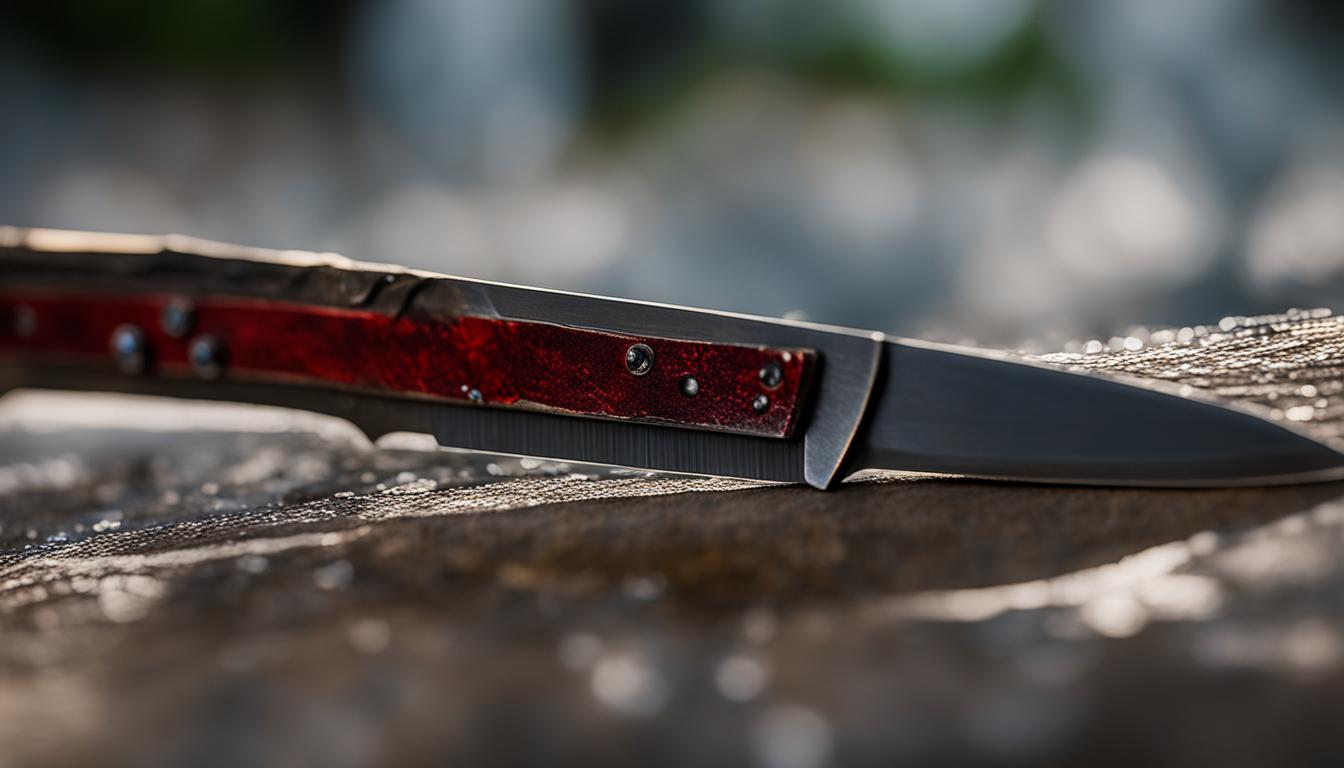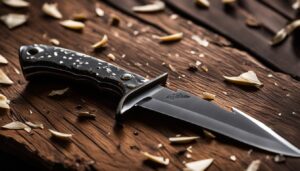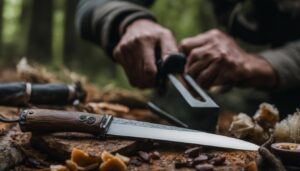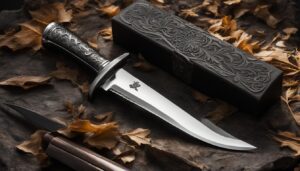Hunting knives are essential tools for hunters, but over time, they can lose their sharpness. Maintaining your knife is crucial for optimal performance, safety, and efficiency in the field. Different types of hunting knives require specific sharpening techniques, and using the right tools and methods can help you preserve the sharpness of your hunting knife.
Before sharpening your hunting knife, it is important to clean the blade, check for nicks and chips, determine the sharpening angle, and choose the appropriate sharpening method. You can use sharpening tools such as sharpening stones, honing rods, electric sharpeners, pull-through sharpeners, and guided sharpening systems to keep your hunting knife sharp.
Using a medium-grit sharpening stone is recommended for sharpening hunting knives, and regular use of a honing rod can help keep the blade sharp for longer. Proper storage of your hunting knife, avoiding using it for unintended tasks, and regularly sharpening the blade are also essential for maintaining sharpness.
Key Takeaways:
- Regular maintenance is crucial for preserving the sharpness of your hunting knife.
- Different types of hunting knives require specific sharpening techniques.
- Sharpening tools like sharpening stones and honing rods can help keep your knife sharp.
- Using a medium-grit sharpening stone is recommended for sharpening hunting knives.
- Regularly using a honing rod and proper storage of your knife can help maintain sharpness.
The Science Behind Knife Sharpening
Knife sharpening is not just a simple task; it involves delving into the intricate science of sharpness. Understanding the physics behind sharpness is key to achieving optimal cutting performance. A sharper blade not only reduces the risk of accidents but also requires less force for cutting tasks, making hunting experiences more efficient. So, what exactly happens when we sharpen a knife?
When a knife blade is dull, its microscopic structure consists of jagged teeth that can snag on materials. However, through sharpening, these burrs are eliminated, resulting in a smoother, cleaner cutting edge. Different sharpening techniques, such as using whetstones or electric sharpeners, produce variations in the abrasion patterns on the blade surface. This is why choosing the right abrasive grit and maintaining consistent angles during sharpening are essential for achieving optimal sharpness.
“A sharper blade reduces the risk of accidents and requires less force for cutting tasks.”
The science behind knife sharpening not only involves understanding the physics of sharpness but also applying the knowledge to achieve the desired cutting edge. It is a fascinating blend of art and science that allows us to maintain the performance and longevity of our hunting knives.
The Importance of Abrasive Grit and Angle Consistency
When sharpening a knife, the choice of abrasive grit is crucial. Different grits on whetstones or in electric sharpeners have varying levels of coarseness, which determines the level of abrasion applied to the blade. Generally, a lower grit, such as 4000, is used to reshape the blade and remove larger nicks, while a higher grit, like 8000, is employed for honing and refining the cutting edge. Maintaining a consistent angle while sharpening is equally important, as it ensures even abrasion across the entire blade surface, resulting in a sharp and balanced edge.
The Art of Achieving Optimal Sharpness
Knife sharpening is not just about removing metal from the blade. It is an art that requires precision and technique. From the choice of sharpening method to the angle at which we hold the blade, every step plays a vital role in achieving optimal sharpness. By understanding the science behind knife sharpening and honing our skills, we can navigate the world of blades with confidence and keep our hunting knives razor-sharp for ultimate performance.
Table: Comparing Different Sharpening Methods
| Sharpening Method | Pros | Cons |
|---|---|---|
| Whetstones | Offers control and versatility Allows for precise angle customization |
Requires skill and practice Takes time and effort |
| Electric Sharpeners | Quick and convenient Automatically maintain correct sharpening angle |
Less control and adaptability May remove more material from the blade |
Understanding Knife Sharpeners: Manual vs Electric
When it comes to sharpening knives, there are two main options to consider: manual methods and electric sharpeners. Each has its own advantages and disadvantages, so it’s important to understand their differences to make an informed decision.
Manual Sharpening
Manual sharpening methods, such as using whetstones or honing rods, offer a hands-on approach that allows for more control and versatility. With manual sharpening, you have the ability to adapt to different blade lengths and shapes, making it a preferred option for those seeking precision.
Whetstones are a popular tool for manual knife sharpening. They come in various grits, ranging from coarse to fine, allowing you to choose the appropriate abrasive for the level of sharpness desired. Angle guides can also be used to ensure consistent sharpening angles, resulting in optimal performance.
Electric Sharpening
On the other hand, electric sharpeners offer convenience and speed. These devices typically have built-in guides that help maintain the correct sharpening angle, making them ideal for quick touch-ups and busy environments.
Electric sharpeners work by sliding the knife blade through designated slots, where rotating abrasive elements do the sharpening. This automated process takes the guesswork out of sharpening and is especially beneficial for those who are less experienced or lack the time to manually sharpen their knives.
| Manual Sharpening | Electric Sharpening |
|---|---|
| Offers more control and adaptability | Convenient and quick |
| Allows for precision | Great for quick touch-ups |
| Requires more skill and practice | Suitable for less experienced users |
When choosing between manual sharpening and electric sharpeners, it’s important to consider your specific needs and preferences. If precision and adaptability are your priorities and you’re willing to invest time in mastering the technique, manual sharpening methods may be the best choice. On the other hand, if convenience and speed are important to you, an electric sharpener could be the more practical option.
Ultimately, the decision boils down to personal preference and the level of control you want to have over the sharpening process. Regardless of the method chosen, it’s crucial to follow proper techniques and safety precautions to ensure optimal results and maintain the longevity of your knives.
Proficiency in Using Whetstones for Knife Sharpening
When it comes to manual knife sharpening, whetstones are a popular and effective tool. Whetstones, also known as sharpening stones, allow for precise control and the ability to achieve a finely honed edge. Mastering the proficiency in using whetstones involves understanding the proper technique, angle selection, and grit selection.
One of the key aspects of using whetstones is maintaining the correct sharpening angle. The angle at which the blade is held against the stone determines the sharpness and durability of the edge. Generally, angles between 15-20 degrees are recommended for most hunting knives. Angle guides can be used to ensure consistent and accurate sharpening angles, especially for beginners.
Grit selection is another important consideration when using whetstones. Whetstones come in a range of abrasive grits, each with its own purpose. Coarse grits, such as 4000, are used for reshaping or repairing damaged blades. Finer grits, like 8000, are used for achieving a polished, razor-sharp edge. Choosing the right grit depends on the condition of the blade and the desired level of sharpness.
Using Whetstones: Step-by-Step Guide
- Place the whetstone on a stable surface, ensuring it won’t move during sharpening.
- Wet the whetstone with water or honing oil to create a lubricating slurry.
- Hold the knife at the desired sharpening angle, using an angle guide if necessary.
- Starting from the base of the blade, move the knife across the stone in a controlled motion. Apply light pressure and maintain a consistent angle.
- Repeat the process on the other side of the blade, alternating strokes to ensure even sharpening.
- Continue sharpening until the desired level of sharpness is achieved, testing the edge periodically.
- Finally, rinse the blade with water and dry it thoroughly before use.
With practice and attention to detail, using whetstones for knife sharpening can become a skill that allows hunters to maintain the sharpness of their knives and optimize their performance in the field.
Comparing Electric and Manual Knife Sharpeners
When it comes to sharpening your hunting knife, you have two options: electric sharpeners or manual methods like whetstones or honing rods. Each option offers its own unique benefits that cater to different needs and preferences.
- The Benefits of Electric Sharpeners:
“Electric sharpeners are known for their speed and convenience. With just a few simple steps, you can quickly restore the sharpness of your hunting knife. These sharpeners often come with built-in guides, making it easier to maintain the correct sharpening angle. They are ideal for busy hunters who need quick touch-ups before heading back into the field.”
- The Benefits of Manual Methods:
“Manual sharpening methods, on the other hand, offer a greater level of control and adaptability. Whetstones and honing rods allow you to fine-tune the sharpening process according to your specific needs. They are perfect for hunters who prefer a hands-on approach and enjoy the precision of manually sharpening their knives.”
Ultimately, the choice between electric and manual sharpeners depends on your personal preferences and the level of control you desire. Electric sharpeners provide convenience and speed, while manual methods offer adaptability and precision. Consider factors like ease of use, sharpening results, and maintenance requirements when making your decision. Regardless of which option you choose, proper technique and safety precautions are important for achieving optimal sharpening results and prolonging the lifespan of your hunting knife.
Comparison Table: Electric vs Manual Knife Sharpeners
| Electric Sharpeners | Manual Methods | |
|---|---|---|
| Speed | Quick and efficient | Requires more time and effort |
| Convenience | Easy to use, ideal for busy hunters | Requires skill and practice |
| Control | Less control over sharpening process | Greater control, adaptability, and precision |
| Sharpening Results | Quick touch-ups, good for maintaining sharpness | Allows for fine-tuning and achieving razor-sharp edges |
| Maintenance | Less maintenance required | Regular cleaning and upkeep necessary |
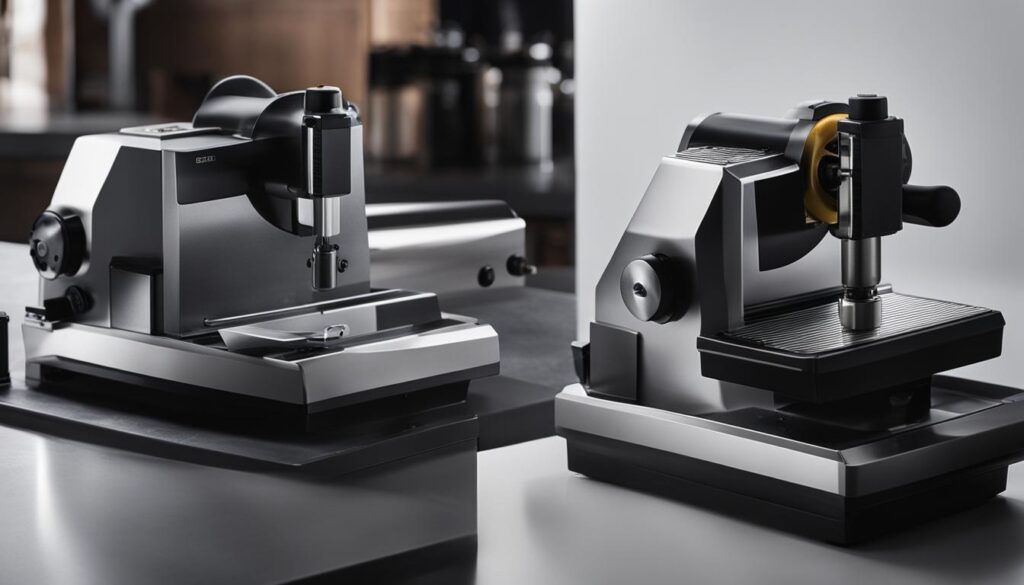
As shown in the comparison table, electric sharpeners offer speed and convenience, making them ideal for hunters who require quick touch-ups and prefer a hassle-free sharpening process. On the other hand, manual methods provide more control and precision, allowing hunters to fine-tune their sharpening technique and achieve razor-sharp edges.
Whichever option you choose, remember to follow proper techniques and safety precautions to ensure optimal sharpening results and maintain the longevity of your hunting knife. Regularly evaluate your sharpening needs and consider factors such as ease of use, sharpening results, and maintenance requirements when deciding between electric and manual sharpeners.
Advanced Techniques for Knife Sharpening
When it comes to achieving razor-sharp edges on your hunting knife, advanced techniques can take your sharpening skills to the next level. One highly effective technique is stropping, which involves using a leather strop and micro abrasive compound to refine the knife’s edge to perfection. To begin, I recommend drawing the knife backward across the strop at a consistent angle, allowing for some experimentation with angles and pressure to find what works best for your knife. Stropping not only polishes and smooths the blade, but it also helps to realign the microscopic metal particles, resulting in a beautifully sharp edge.
Another tool that can enhance your knife sharpening process is the BESS (Brubacher Edge Sharpness Scale) tester. This device is used to measure the sharpness of a knife’s edge accurately. By understanding the numerical measurements provided by the BESS tester, you can gain valuable insights into the effectiveness of your sharpening techniques. It’s important to note that the BESS tester measures the pressure required to cut through a standardized material, allowing you to objectively evaluate the sharpness of different knives or compare the effects of various sharpening methods.
| Technique | Description |
|---|---|
| Stropping | A technique that involves using a leather strop to refine the knife’s edge and achieve a razor-sharp finish. It helps to polish and smooth the blade and realign microscopic metal particles. |
| BESS Testing | Using a BESS tester to measure the sharpness of a knife’s edge accurately. It provides numerical measurements that allow for objective evaluation of sharpening techniques and comparisons between different knives or methods. |
Mastering these advanced knife sharpening techniques takes practice, finesse, and attention to detail. It’s important to note that these techniques should be used in conjunction with proper maintenance and care of your sharpening tools and knives to ensure optimal performance and safety. By incorporating these advanced techniques into your sharpening routine, you’ll be able to achieve and maintain razor-sharp edges on your hunting knife for longer periods of time, enhancing your hunting experience.
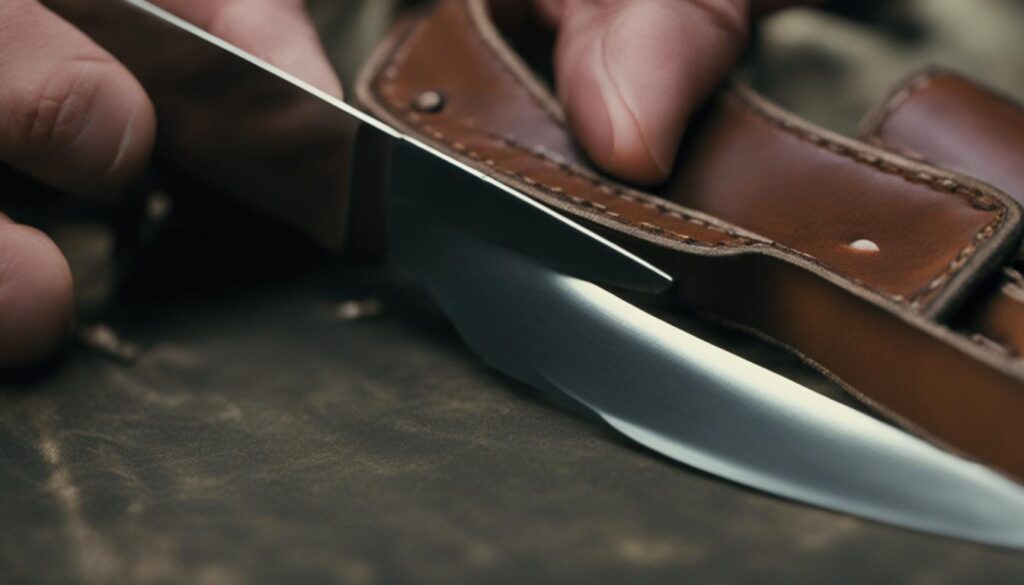

Troubleshooting and Safety Precautions in Knife Sharpening
When it comes to knife sharpening, troubleshooting common issues and taking necessary safety precautions are essential for achieving optimal results and maintaining personal safety. Whether you’re a seasoned professional or a novice, understanding how to troubleshoot common problems and follow safety guidelines will help you sharpen your knives effectively and avoid accidents.
Common Issues in Knife Sharpening
One common issue encountered during knife sharpening is not achieving the desired level of sharpness. This can be due to various factors, such as using the wrong sharpening technique or not maintaining the correct angle. To troubleshoot this problem, it is important to assess the sharpness of the blade before and after sharpening. If the result is not satisfactory, you may need to adjust your technique or switch to a different sharpening method.
Another issue that knife sharpeners may encounter is uneven sharpening. This occurs when one part of the blade is sharpened more than the others, resulting in an imbalanced edge. To troubleshoot this problem, pay close attention to the angle and pressure applied during sharpening. Maintaining consistency is crucial for achieving an even edge. If necessary, practice with a dull knife or seek guidance from experienced sharpeners to improve your technique.
Safety Precautions for Knife Sharpening
Knife sharpening involves working with sharp blades, making safety precautions a top priority. Here are some important safety guidelines to follow:
- Wear protective gloves: To protect your hands from potential cuts or injuries, always wear protective gloves while sharpening knives. This will provide an additional layer of safety.
- Maintain a consistent angle: Keeping a consistent sharpening angle is not only crucial for achieving optimal sharpness but also for safety. A consistent angle ensures that the blade is sharpened evenly and reduces the risk of accidents.
- Secure the knife: When sharpening a knife, make sure it is securely held in place. This minimizes the chances of slipping and prevents injuries.
- Use a stable surface: Sharpen your knives on a stable and non-slip surface to prevent accidents. Avoid sharpening on uneven or slippery surfaces that may compromise your stability.
By troubleshooting common issues and following safety precautions, you can ensure a successful and safe knife sharpening experience. Remember to always prioritize personal safety and take the necessary steps to maintain the sharpness and integrity of your knives.
| Problem | Troubleshooting |
|---|---|
| Dull blades after sharpening | – Ensure you are using the correct sharpening technique – Double-check the sharpening angle – Try a different sharpening method or tool |
| Uneven sharpening | – Pay attention to angle consistency – Adjust pressure for even sharpening – Seek guidance or practice to improve technique |
| Inadequate sharpness | – Assess the sharpness before and after sharpening – Make necessary adjustments to technique – Consider alternative sharpening methods or tools |
Conclusion
Keeping hunting knives sharp is essential for hunters. Mastering the art of knife maintenance and sharpening is crucial for optimal performance, safety, and efficiency. Understanding the science behind sharpness, choosing the right sharpening tools and techniques, and practicing regularly can lead to long-lasting sharpness.
Whether using manual methods or electric sharpeners, following proper techniques and safety precautions is important. With patience, practice, and attention to detail, hunters can preserve the sharpness of their hunting knives for longer periods of time.
FAQ
How often should I sharpen my hunting knife?
It is recommended to sharpen your hunting knife regularly, especially if you notice a decrease in its cutting performance. The frequency can vary depending on how often you use the knife and the tasks you use it for. Generally, sharpening your hunting knife every few months or whenever it starts to feel dull is a good practice.
Can I use a regular sharpening stone for my hunting knife?
Yes, you can use a regular sharpening stone for your hunting knife. However, it is advisable to use a medium-grit sharpening stone specifically designed for hunting knives. These stones are more effective in maintaining the sharpness of the blade and are less likely to damage the knife.
How do I determine the correct sharpening angle for my hunting knife?
The sharpening angle for hunting knives typically ranges from 15 to 20 degrees. To determine the correct angle, you can consult the manufacturer’s instructions or use an angle guide. Holding the knife at the correct angle while sharpening is crucial to achieving optimal sharpness.
Can I use an electric sharpener for my hunting knife?
Yes, you can use an electric sharpener for your hunting knife. Electric sharpeners are convenient and quick, making them a popular choice for many hunters. However, it is important to choose an electric sharpener specifically designed for hunting knives and follow the manufacturer’s instructions to avoid damaging the blade.
How do I maintain the sharpness of my hunting knife?
To maintain the sharpness of your hunting knife, it is advisable to use a honing rod regularly. A honing rod helps realign the edge of the blade, keeping it sharp. Additionally, storing your knife properly, avoiding using it for unintended tasks, and regularly sharpening the blade can help prolong its sharpness.
What is stropping and how does it help in knife sharpening?
Stropping is the final step in the knife-sharpening process. It involves using a leather strop and micro abrasive compound to refine the knife’s edge. By drawing the knife backward across the strop at a consistent angle, you can further polish the blade and achieve a razor-sharp edge.
What safety precautions should I take while sharpening my hunting knife?
When sharpening your hunting knife, it is important to wear protective gloves to prevent any injuries. Additionally, maintaining a consistent sharpening angle and being cautious of the blade’s position are essential for safety. Always follow the manufacturer’s instructions for the sharpening tools you are using and exercise caution to avoid accidents.
